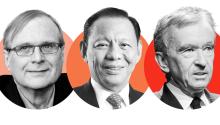Amundi on value creation, asset market outlook and ESG investing

Amundi SA's alternative and real assets business launched in 2016 with the ambition to integrate all its unlisted assets expertise in real estate, private debt, private equity and infrastructure. This was in response to growing investor demand for such asset classes, through which it is possible to capture an illiquidity premium and diversify portfolios. Since then, funds under management have doubled to €54 billion ($58 billion)—hitting the target the firm set itself when it launched the platform.
Platform head Pedro Antonio Arias discusses Amundi’s steep growth in this area, it’s predominantly retail investor base and how this shaped the business’s strategy.
What did Amundi’s private asset platform look like in 2016 and how has it grown over the past three and a half years?
In 2016, the businesses we had on the platform were real estate, private debt, hedge funds, private equity and infrastructure. We had just started on the renewable infrastructure business and our innovation strategy, partnering with power utility company EDF SA. We’ve closed the hedge fund business, and we’ve developed the private equity, the private debt and the rest.
Our assets under management of €54 billion ($59 billion) are split in a balanced way between retail clients and institutional investors. Two things have been pushing the astonishing growth of private markets: high performance and portfolio diversification. Two benefits that investors cannot find with traditional bonds and equities. This is only the beginning, as I believe retail is certainly the next clientele to join private markets and push the growth of this industry even higher. Retail is really our DNA, so we’re very much in advance on that forefront: Amundi is backed by Credit Agricole’s banking networks, one of the most powerful on the European continent.
The only limit to it being the logistics of having a firm that is able to raise the level of its services in terms of transparency and reporting in order to cope with requirements from individuals. This also implies a good pedagogy, a good explanation of the characteristic of the products we’re selling, which are, as you know, very different from the traditional ones.
Can you tell us more about the famed “illiquidity premium”?
Amundi believes that investors should pay more attention to the ability of alternative asset managers to generate value when considering both the current price of listed equities—especially after the recent rally—and the level of dry powder in private markets (more than €600 billion or $657 billion in Europe according to Preqin). For example, the Private Debt asset class captures multiple sources of premium versus listed bonds thanks to a stringent legal package of guarantees. Asset managers can negotiate and design tailor-made portfolios with higher protection for investors—which is not possible with public bonds. This advantage would be pivotal to protect investors in the event of a default. This is why, despite its relative illiquidity, we anticipate an acceleration in demand for this asset class in the coming years.

The situation is comparable with Private Equity where GPs can help corporates grow and become stronger in the following areas: strategic plan, business operations, international development, business network, financial organisation, governance, etc. An active GP builds the future value of the firm and anticipates exit conditions as soon as possible. However, investors could question value creation when the same firm has been acquired and sold several times after multiple LBOs.
Are there other drivers for value creation that investors should know more about?
Definitely. Value creation is also driven by fee structure. Needless to say that locking capital for more than 10 years in a private equity or real estate fund is a tough liquidity constraint for investors. Their concerns regarding fee structures are understandable as high fees could erode potential return. Investors have the right to know from the beginning if they are paying fees on the capital they commit or on the capital being invested. No one wants to pay management fees on capital that is languishing in a bank account. At Amundi we believe in fair pricing structures where fees are applied only on capital having been deployed. On a global scale, this trend is gaining traction and it should become a standard practice in the private and real assets industry.
What’s the outlook for the alternative and real asset markets?
Amundi is taking an increasingly significant place in these markets in France and Europe, markets which are themselves experiencing a sustain growth with today more than €1.6 billion ($1.7 billion) under management in Europe (source: Preqin). This industry benefits from both a favourable macroeconomic (low growth, low interest rate, accommodative monetary policy, etc) and regulatory (Solvency 2, ELTIF, PACTE Law, etc) environment.
We’ve doubled the size of our funds under management in three years to reach the €50 billion ($54 billion) landmark, and we should continue to climb easily with organic growth. We are now the second largest money raiser within Amundi after bonds because demand is here, but the market is pushing, clients are very demanding in terms of services, transparency and education.

Finally, can we talk about ESG investing—it is such a big thing lately?
We see that investors are more and more considering value creation over the long-term. They want sustainability in their investments. This sustainability is made possible thanks to the right ESG [environmental, social and governance] approach, which can be another strategy to mitigate investment risks. Amundi is heavily committed to Responsible Investment. Working with real assets makes this both a more obvious and a more demanding undertaking. Today, 100% of our properties meet Amundi SRI-ESG criteria, as do the mid-caps in which we are investing through equity and debt. On top of analysis and ex-ante scoring, we are introducing KPIs in order to improve SRI-ESG rating throughout the duration of our investments.






